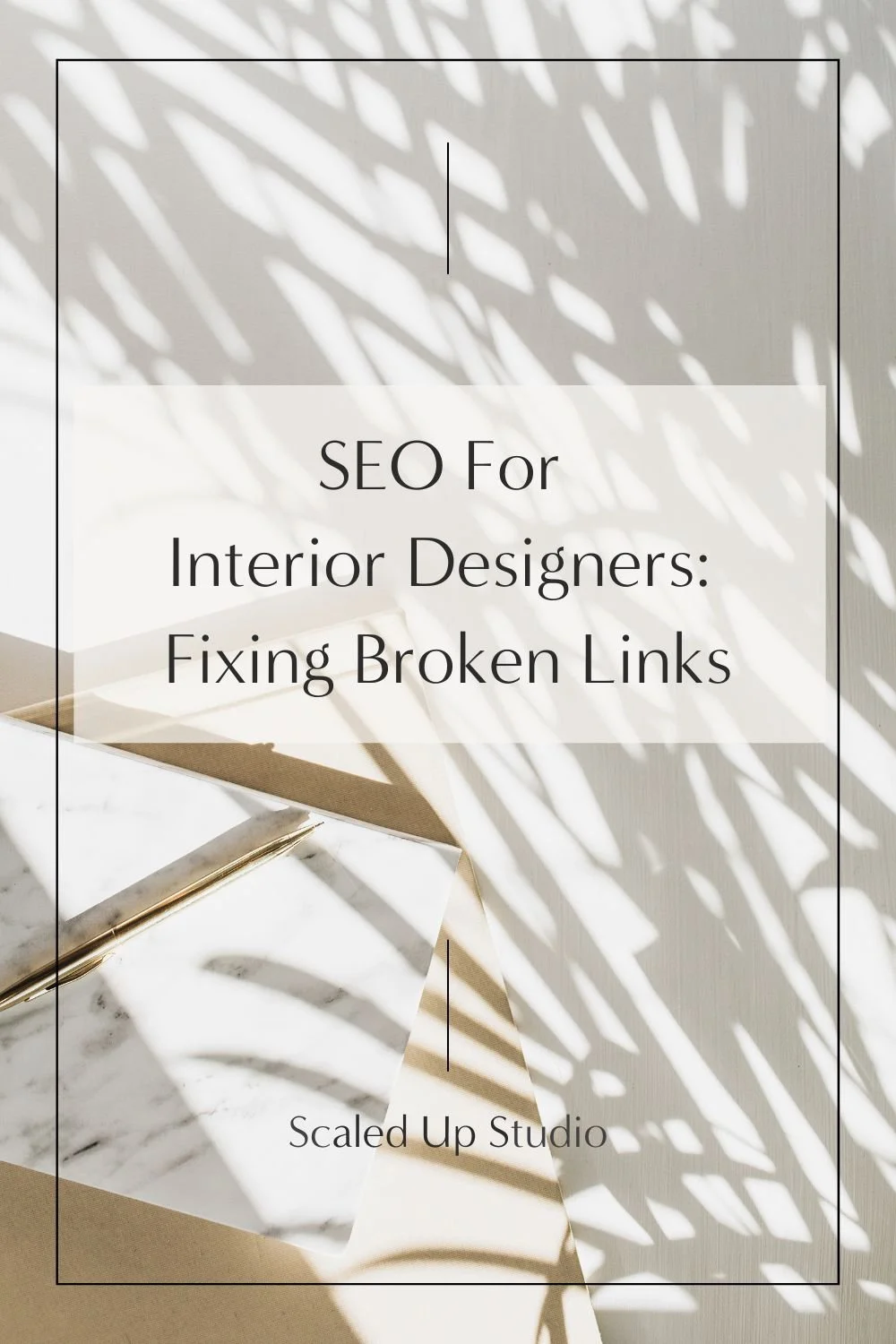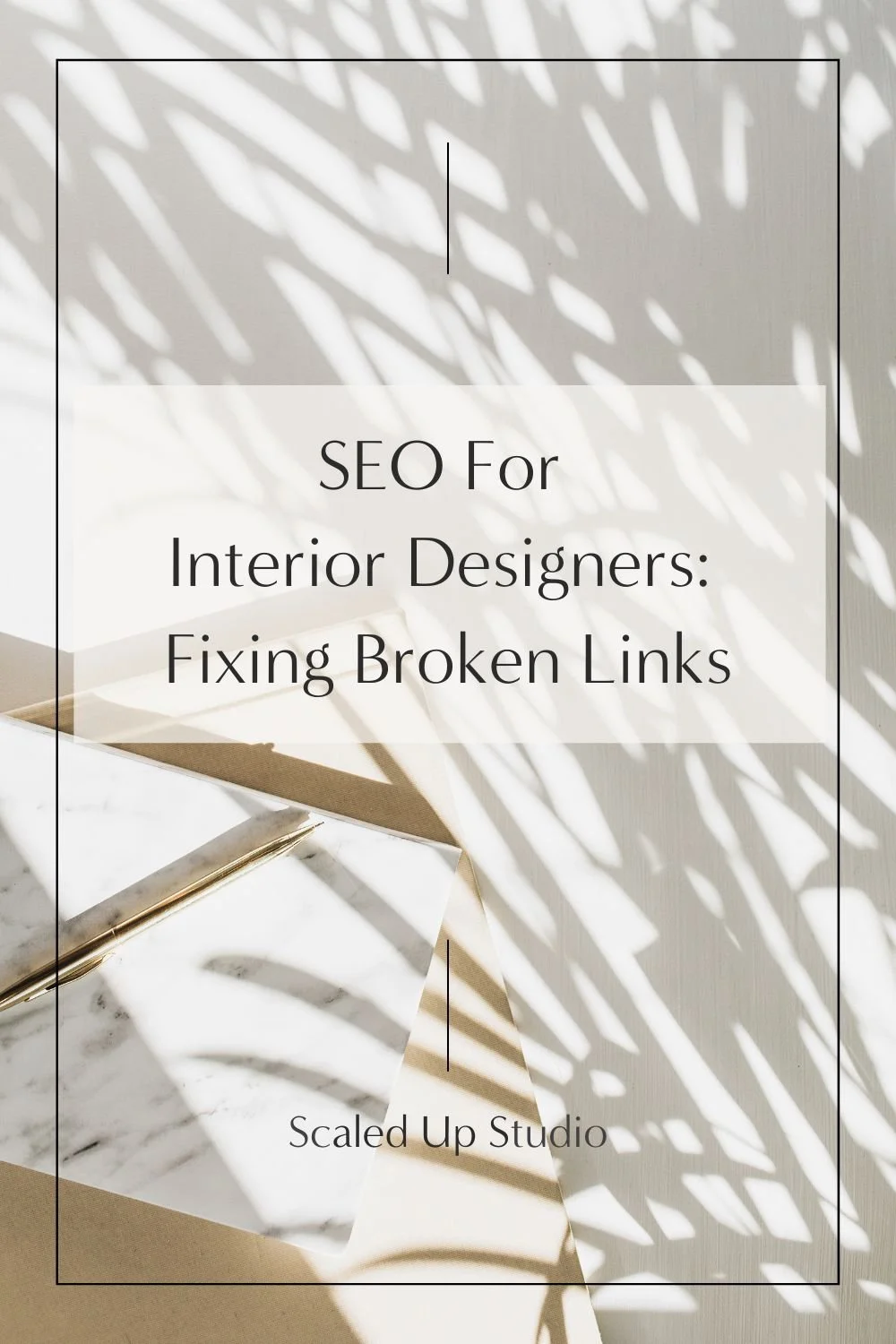SEO For Interior Designers: Fixing Broken Links
SEO is the holy grail of website success, and today’s post is an easy fix for a possible SEO quick win. If your interior design website has strong SEO (search engine optimization) you don’t need to worry much about constantly being on the social media hamster wheel or running paid ads because you have that sweet, sweet organic traffic bringing visitors to your site.
If you have a straightforward interiors or architectural website that focuses mostly on your portfolio, you may not have many pages or links. However, if you’ve been blogging as an SEO strategy to drive traffic for a long time, you likely have a lot of links and should run your site through a broken link checker regularly.
Whether your interior design/architectural site is large or small, I recommend running a link check periodically to make sure everything’s ship-shape. It’s a simple process and only takes a few minutes, so let’s dive in.
What are broken links and why are they problematic?
Broken links create a poor user experience and are bad for SEO (search engine optimization). Broken links are a cause of frustration for website visitors who are trying to find information and can’t. They can drive people away from a website and onto a competitor’s website and make those potential clients/customers less likely to return to or recommend your website.
Let’s look at how broken links happen and the two types of links - external vs. internal.
External links: (links from your site to another site)
Say you linked to the website of an architect you collaborate with, but down the road they rebranded and changed their domain name or they just changed the URL of a page that you had linked to. If they didn’t also do what’s called a “redirect” to connect the old page name to the new one, then your external link will now be broken.
A URL stands for Uniform Resource Locator and is any web address. It’s made up of the domain name (www.yoursite.com) plus a “slug” which are the words that come after the domain name. (example - www.scaledupstudio.com/about - “about” is the slug.) So your homepage doesn’t have a slug (usually), it’s just the domain name, e.g. - www.yoursite.com.
If a visitor on your site clicks on the architect’s broken link they will see that architect’s website’s “404 error” page.
Internal links: (links within your own website)
If you ever wrote a blog post and within that post you linked to one of your own blog posts but then later changed the URL of that blog post, then you will have a broken internal link.
For example, if my original About page had the slug “www.scaledupstudio.com/about-tina-huffman” and then I changed it to “www.scaledupstudio.com/about” then any links to “www.scaledupstudio.com/about-tina-huffman” will be broken internal links unless I fix them.
Any external links will also be broken if say if that architect also linked back to your original About page slug from their site.
The visitor who clicks on any of these links will see your website’s “404 error” page.
If you want to see my 404 error page or anyone else’s, just type in the domain plus any nonsense slug and it will show the 404 error page. Some people have creative ones! (Mine actually has a low-key Wallace and Grommit reference - my boys and I are huge fans :)
Internal links play an important role in SEO because they help search engines understand what a website is about and how information on a website relates to each other. A site’s internal link structure is considered a critical ranking factor by Google, which means that broken internal links can cause a site to miss out on search engine traffic.
Bounce rate
If your visitors are clicking on links that are broken, this isn’t a good user experience and means they’re more likely to click off your website all together. In website analytics terms, this can lead to a higher Bounce Rate.
Your bounce rate represents the number of visitors who view one page on your site and then leave without clicking through to another page.
I don’t want to get into the SEO weeds here, but a high bounce rate isn’t always bad. For the purposes of most interior design websites though, you do want a lower bounce rate since you want people to stick around and click around to find out more about your design services, hopefully leading to an inquiry.
Learn from my mistakes: I just finished fixing a whole lotta broken links on this site. An embarrassingly large number of them. Why? Because about a year ago (a year!) I changed the business name and therefore my domain name.
Did I know that I had to change out all of those links prior? Yes I did. So how did I end up with so many for so long? That is a good question. One reason is the link checker I was using only lists single instances of a broken link.
I have a 10 part blog series discussing how to start a design business. Each post lists and links to each of the other 10 posts. (This is part of an SEO strategy called Pillar Content which is a subject for another post.) Therefore, I had 10 instances of the same10 blog posts, which all had the same broken links. Not pretty.
So be careful if you copy/paste links for use in multiple places on your site!
It seems that in my mind, I had given myself the “mental check off” for having done all of this, and yet I hadn’t completed it all the way. I’m sure it had some affect on my SEO, so I will be watching carefully in the coming months to see if Scaled Up Studio has an uptick in organic traffic. (Update - yes we did!)
What I’m doing differently: Now, checking for broken links is part of my end-of-month SOP (standard operating procedure) so things don’t ever get out of hand again.
You don’t have to be hypervigilant though - some broken links are to be expected and Google understands this. You do not have to fix each and every broken link (and sometimes you just can’t) but do clean up the important links and the low hanging fruit.
So by this point you may be wondering how to even know if your interior design website has broken links. 😅
There’s an easy solution- you just choose a free broken link checker, enter your website URL and let it check for you. After the work I just finished with Scaled Up Studio, here are two free broken link checkers that I like:
When you get your list of broken links, click through to find the referring link on your website and its associated link text, then fix them on your site.
Re-run the tests; they will update in real time.
Conclusion
Running a simple diagnostic on your website periodically to find your broken links is an easy way to stay on top of your website’s “health.” Having some broken links is fine and to be expected, but if you have too many it can affect your visitor’s experience and your SEO.
The goal for most home design professional’s websites is for site visitors to find the information they’re looking for and either inquire about services or make a purchase. Cleaning up any broken links will help out with that, so make a recurring date on your calendar to run this simple diagnostic.
[This post contains affiliate links. Click here to read my full disclosure.]
New to Squarespace? You can sign up for a free trial, and I can even get you a discount! Use code GREENHOUSE10 to save 10% off your first year. (affiliate link)
New to Canva? Canva's FREE version is amazing! It makes design work fun and easy. (affiliate link)
Other interior design business-building posts you’ll love:
Don’t forget to Pin it for later!
If you have any questions or comments, please drop me a note below. Be sure to check back for my response (I always respond) since no notification is sent.


